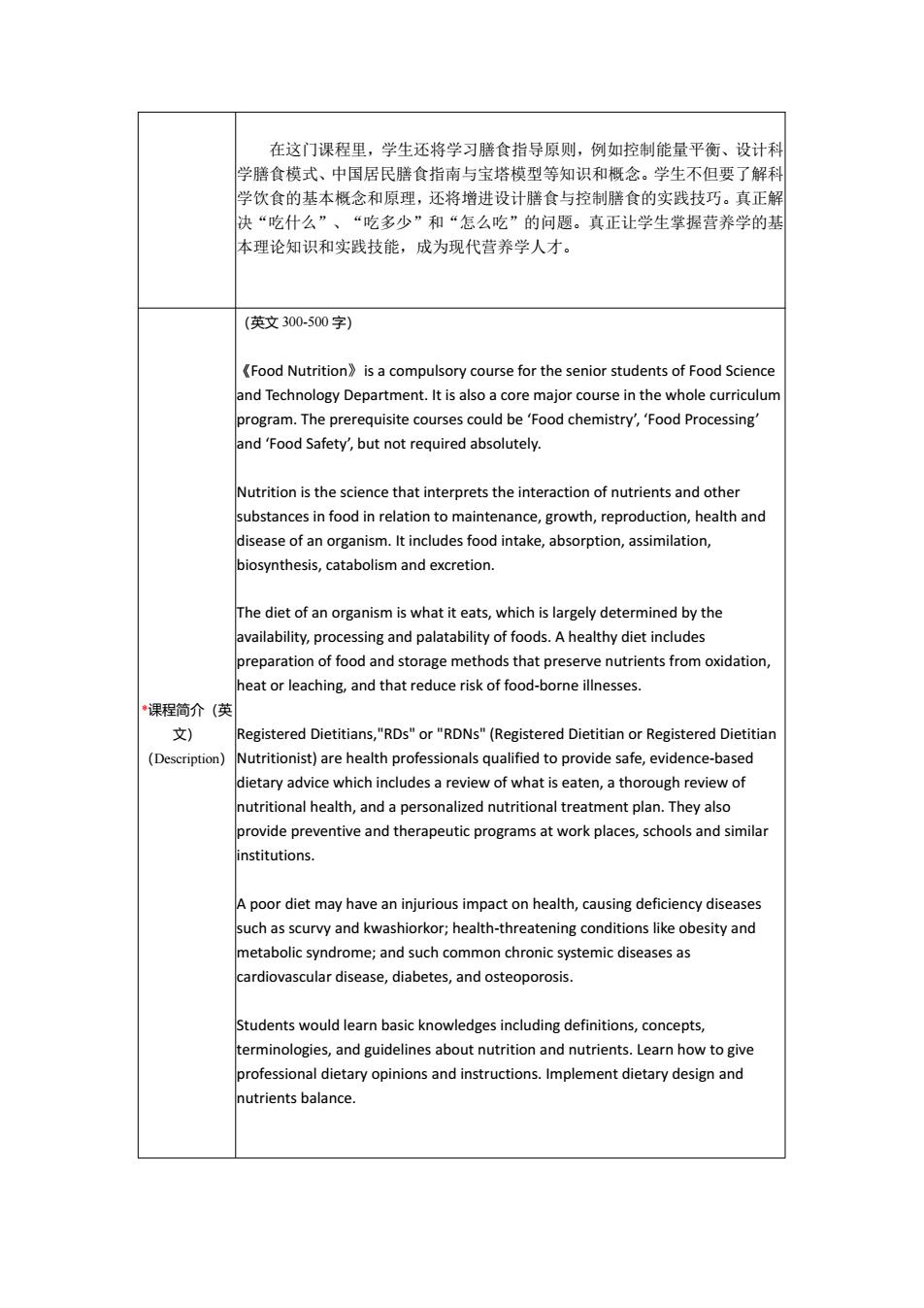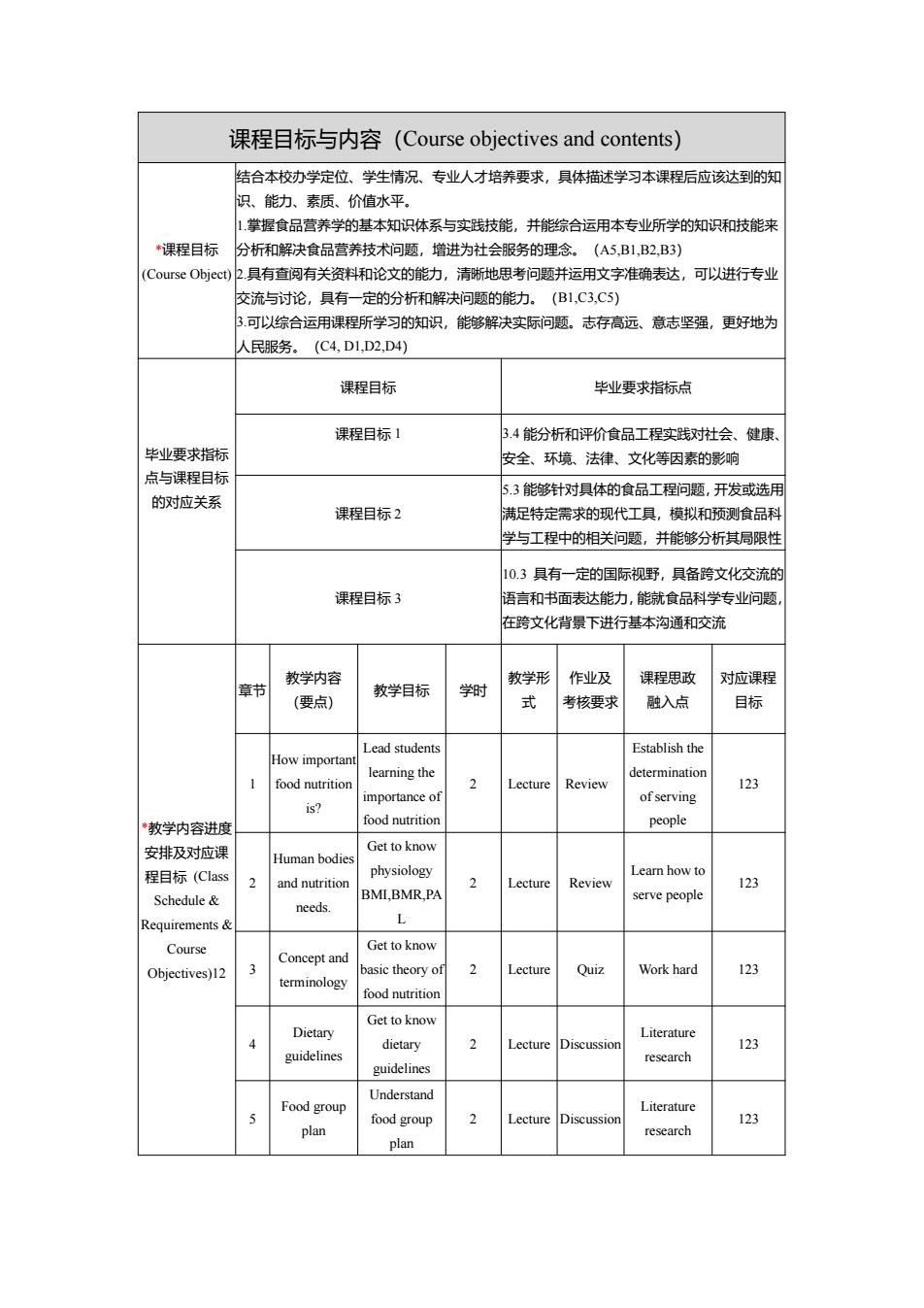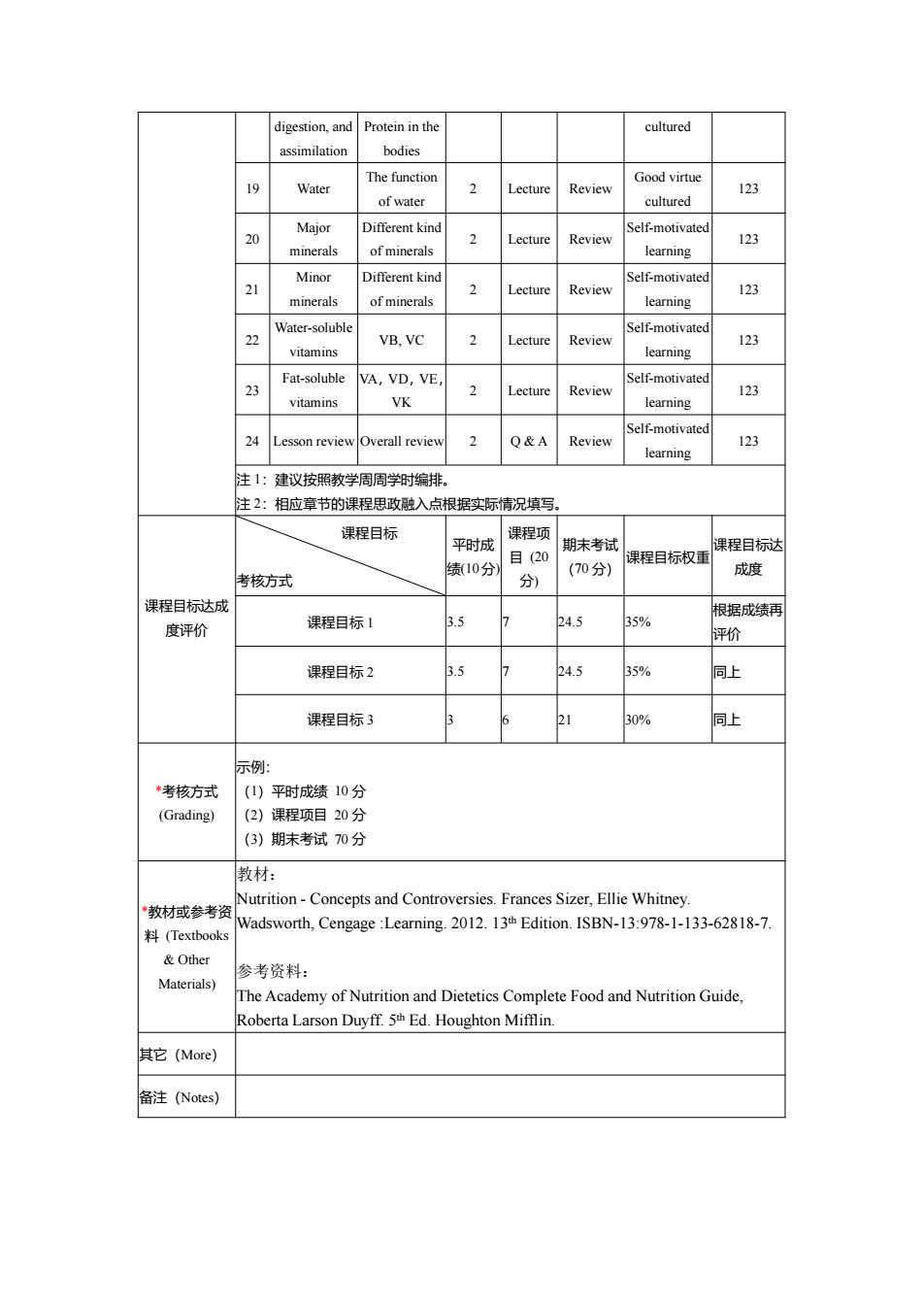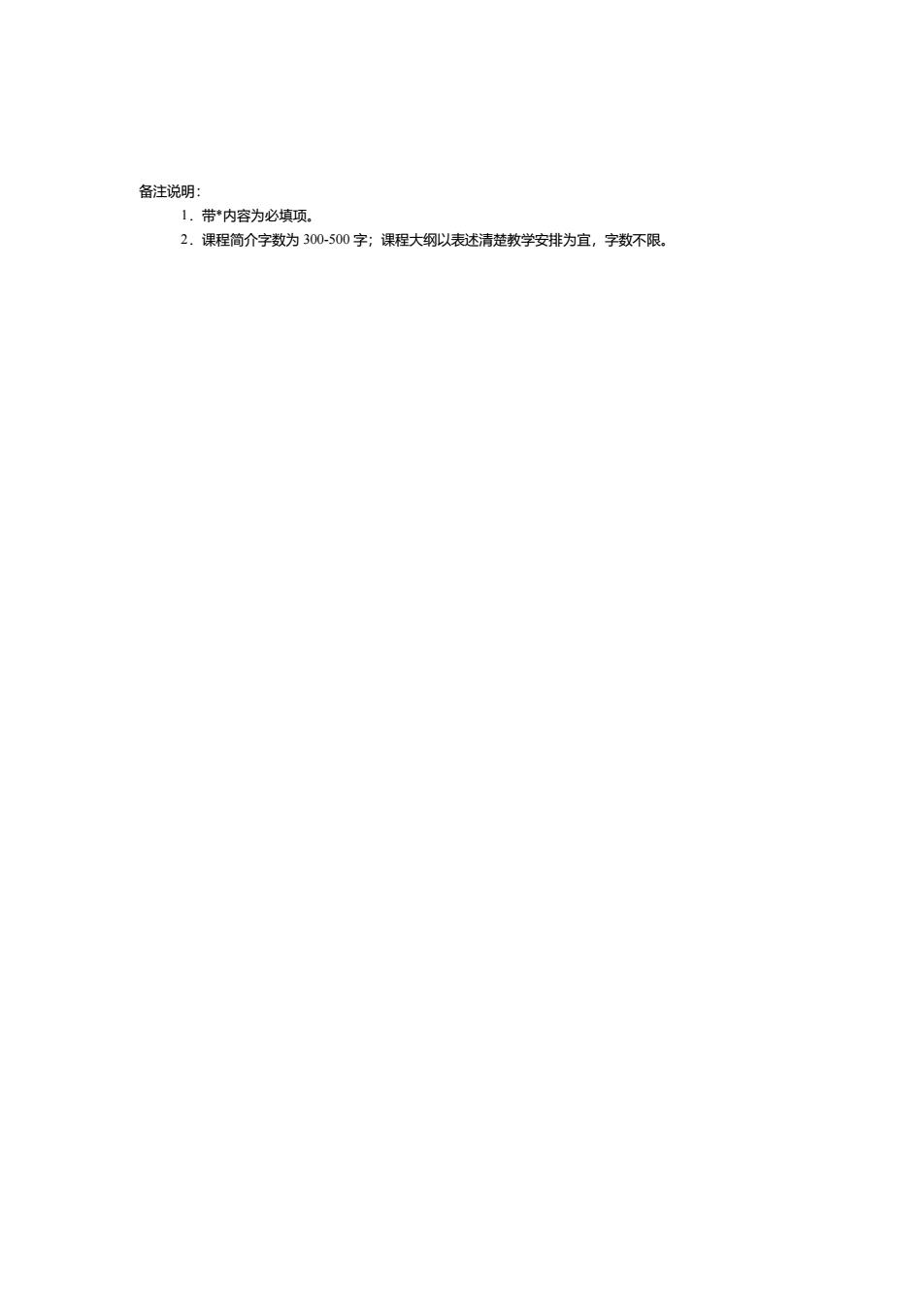
《食品营养学》课程教学大纲(2020级) 课程基本信息(Course Information) 课程代码 *学时 0sT440 学粉 Course Cod (Credits) “课程名称 (中文)食品营养学 (Course Name) 英文)Food Nutrition 课程类型 (Course Type mpulsory Course 授课对象 (Targe nior Students of Food Science and Technology Department Audience) 授课语言 (Language of English (or Bilingual depends on requirement Instruction) 开理院 chool of Agriculture and Biology 先修课程 Food Chemistry, Food 后续课 程 (Prerequisite)Processing.ect.. post) 课程网 址 课程负责人 盛潑副教授 (Course (Instructor) Webpage (中文300-500字,含课程性质、主要教学内容、课程教学目标等) 《食品营养学》是食品科学与工程专业的专业必修课程。是面向本专业 四年级学生开设的专业核心课,先修课程包括《食品化学》、《食品安全学》 以及《食品工艺学》等专业课程。《食品营养学》自成体系,也可以独立开设 或者面向全校作为通识类课程。 课程简介(中 食品营养学是研究食物营养素及其他生物活性物质对人体健康的生理 文) 用和有益影响的科学。通过学习食品中的能量平衡和基本六大营养素,诸如水 分、蛋白质、脂肪、碳水化合物、维生素及矿物质,了解这些营养素的基本化 学组成、分类、理化特性、营养学作用,并进一步学习这些营养元素在人体内 的消化、吸收、转运和 代谢机制。明了能量失衡、营养元素缺乏或过剩,对人 体健康带来的潜在不利影响。理解并掌握与食物营养相关的疾病,以及不同人 群(包括儿童与青少年、孕妇与乳母、老年和特殊疾患人群)对食物营养的需 求
《食品营养学》课程教学大纲(2020 级) 课程基本信息(Course Information) 课程代码 (Course Code) FOST4401 *学时 (Credit Hours) 48 *学分 (Credits) 3 *课程名称 (Course Name) (中文)食品营养学 (英文)Food Nutrition 课程类型 (Course Type) Compulsory Course 授课对象 (Target Audience) Senior Students of Food Science and Technology Department 授课语言 (Language of Instruction) English (or Bilingual depends on requirement) *开课院系 (School) School of Agriculture and Biology 先修课程 (Prerequisite) Food Chemistry, Food Processing, ect.. 后续课 程 (post) *课程负责人 (Instructor) 盛漪 副教授 课程网 址 (Course Webpage ) *课程简介(中 文) (Description) (中文 300-500 字,含课程性质、主要教学内容、课程教学目标等) 《食品营养学》是食品科学与工程专业的专业必修课程。是面向本专业三、 四年级学生开设的专业核心课,先修课程包括《食品化学》、《食品安全学》 以及《食品工艺学》等专业课程。《食品营养学》自成体系,也可以独立开设 或者面向全校作为通识类课程。 食品营养学是研究食物营养素及其他生物活性物质对人体健康的生理作 用和有益影响的科学。通过学习食品中的能量平衡和基本六大营养素,诸如水 分、蛋白质、脂肪、碳水化合物、维生素及矿物质,了解这些营养素的基本化 学组成、分类、理化特性、营养学作用,并进一步学习这些营养元素在人体内 的消化、吸收、转运和代谢机制。明了能量失衡、营养元素缺乏或过剩,对人 体健康带来的潜在不利影响。理解并掌握与食物营养相关的疾病,以及不同人 群(包括儿童与青少年、孕妇与乳母、老年和特殊疾患人群)对食物营养的需 求

在这门课程里,学生环将学习膳食指导值叫,制如控制能量平、设计科 学膳食模式、中国居民膳食指南与宝塔模型等知识和概念。 学生不但要了解科 学饮食的基本概念和原理,还将增进设计膳食与控制膳食的实践技巧,真正解 快“吃什么”、“吃多少”和“怎么吃”的问题。真正让学生掌握营养学的基 本理论知识和实践技能,成为现代营养学人才。 (英文300-500字) Food Nutrition)is a compulsory course for the senior students of food science program.The prerequisite courses could be'Food chemistry,Food Processing' and 'Food Safety',but not required absolutely. Nutrition is the science that interprets the interaction of nutrients and other substances nood,growth,reproduction,healthand disease of an organism.It includes food intake,absorption,assimilation, biosynthesis,catabolism and excretion. The diet of an organism is what it eats,which is largely determined by the availability,processingand palatability of foods.A healthy diet inudes eat or leaching,and that reduce risk of food-borne illnesses 课程简介(英 文) Registered Dietitians,"RDs"or"RDNs"(Registered Dietitian or Registered Dietitian (Descriptin)Nutritionist)are health professionals qualified to provide safe,evidence-based dietary advice which includesa review of,a thoroug review of provide preventive and therapeutic programs at work places,schools and simila nstitutions. A poor diet may havean,causing and kwashiorkor; metabolic syndrome;and such common chronic systemic diseases as cardiovascular disease,diabetes,and osteoporosis. Students would learn basic knowledges including definitions,concepts professional dietary opinions and instructions.Implement dietary design and utrients balance
在这门课程里,学生还将学习膳食指导原则,例如控制能量平衡、设计科 学膳食模式、中国居民膳食指南与宝塔模型等知识和概念。学生不但要了解科 学饮食的基本概念和原理,还将增进设计膳食与控制膳食的实践技巧。真正解 决“吃什么”、“吃多少”和“怎么吃”的问题。真正让学生掌握营养学的基 本理论知识和实践技能,成为现代营养学人才。 *课程简介(英 文) (Description) (英文 300-500 字) 《Food Nutrition》is a compulsory course for the senior students of Food Science and Technology Department. It is also a core major course in the whole curriculum program. The prerequisite courses could be ‘Food chemistry’, ‘Food Processing’ and ‘Food Safety’, but not required absolutely. Nutrition is the science that interprets the interaction of nutrients and other substances in food in relation to maintenance, growth, reproduction, health and disease of an organism. It includes food intake, absorption, assimilation, biosynthesis, catabolism and excretion. The diet of an organism is what it eats, which is largely determined by the availability, processing and palatability of foods. A healthy diet includes preparation of food and storage methods that preserve nutrients from oxidation, heat or leaching, and that reduce risk of food‐borne illnesses. Registered Dietitians,"RDs" or "RDNs" (Registered Dietitian or Registered Dietitian Nutritionist) are health professionals qualified to provide safe, evidence‐based dietary advice which includes a review of what is eaten, a thorough review of nutritional health, and a personalized nutritional treatment plan. They also provide preventive and therapeutic programs at work places, schools and similar institutions. A poor diet may have an injurious impact on health, causing deficiency diseases such as scurvy and kwashiorkor; health‐threatening conditions like obesity and metabolic syndrome; and such common chronic systemic diseases as cardiovascular disease, diabetes, and osteoporosis. Students would learn basic knowledges including definitions, concepts, terminologies, and guidelines about nutrition and nutrients. Learn how to give professional dietary opinions and instructions. Implement dietary design and nutrients balance

课程目标与内容(Course objectives and contents) 结合本校办学定位。学生情况、专业人才培养要求,具体描述学习本课程后应该达到的知 识能力.素质价值水平 1.掌探食品营养学的某本知识体系与实线技能。并能综合运用本专业所学的知识和技能来 课程目标 分析和解决食品营养技术问题,增进为社会服务的理念。 (A5.BI.B2.B3) (c)P,具有查阅有关资料和论文的能力,清晰地思考问题并运用文字准确表达,可以进行专 交流与讨论,具有一定的分析和解决问题的能力。(B1,C3,C5) 3.可以综合运用课程所学习的知识,能够解决实际问题。志存高远、意志坚强,更好地为 人民服务.(C4,D1.D2.D4) 课程目标 毕业要求指标点 课程目标1 3.4能分析和评价食品工程实践对杜会、健康。 毕业要求指标 安全、环境、法律、文化等因素的影响 点与课程目标 5.3能够针对具体的食品工程问题,开发或选用 的对应关系 课程目标2 满足特定需求的现代工具,模拟和预测食品科 学与工程中的相关问题,并能够分析其局限性 0.3具有一定的国际视野,具备跨文化交流 课程目标3 语言和书而表达能力,能就食品科学专业问题 在跨文化背景下进行基本沟通和咬流 章节 教学内容 教学形作业及 课程思政 对应课程 教学目标 (要点) 考核要求 融入点 目标 Lead student Establish the How importa ning the food nutritio 2 Lecture Review 123 mportance c of serving Is? *教学内容进 food nutrition people 安排及对应课 Get to know uman bodies 程目标(Class 2 ptysiology Leam howt and nutritio Schedule BMI.BMR.P 2 Lecture Review 123 serve peopl Get to know Objectives)12 3 asic theory 2 Lecture Work hard 123 Get to know Dietary Literature dietary Lecture Discussio guidelines rescarch 123 uidelin Food group food group Lecture 123 plan research plan
课程目标与内容(Course objectives and contents) *课程目标 (Course Object) 结合本校办学定位、学生情况、专业人才培养要求,具体描述学习本课程后应该达到的知 识、能力、素质、价值水平。 1.掌握食品营养学的基本知识体系与实践技能,并能综合运用本专业所学的知识和技能来 分析和解决食品营养技术问题,增进为社会服务的理念。(A5,B1,B2,B3) 2.具有查阅有关资料和论文的能力,清晰地思考问题并运用文字准确表达,可以进行专业 交流与讨论,具有一定的分析和解决问题的能力。(B1,C3,C5) 3.可以综合运用课程所学习的知识,能够解决实际问题。志存高远、意志坚强,更好地为 人民服务。(C4, D1,D2,D4) 毕业要求指标 点与课程目标 的对应关系 课程目标 毕业要求指标点 课程目标 1 3.4 能分析和评价食品工程实践对社会、健康、 安全、环境、法律、文化等因素的影响 课程目标 2 5.3 能够针对具体的食品工程问题,开发或选用 满足特定需求的现代工具,模拟和预测食品科 学与工程中的相关问题,并能够分析其局限性 课程目标 3 10.3 具有一定的国际视野,具备跨文化交流的 语言和书面表达能力,能就食品科学专业问题, 在跨文化背景下进行基本沟通和交流 *教学内容进度 安排及对应课 程目标 (Class Schedule & Requirements & Course Objectives)12 章节 教学内容 (要点) 教学目标 学时 教学形 式 作业及 考核要求 课程思政 融入点 对应课程 目标 1 How important food nutrition is? Lead students learning the importance of food nutrition 2 Lecture Review Establish the determination of serving people 123 2 Human bodies and nutrition needs. Get to know physiology BMI,BMR,PA L 2 Lecture Review Learn how to serve people 123 3 Concept and terminology Get to know basic theory of food nutrition 2 Lecture Quiz Work hard 123 4 Dietary guidelines Get to know dietary guidelines 2 Lecture Discussion Literature research 123 5 Food group plan Understand food group plan 2 Lecture Discussion Literature research 123

6 calculation 2 Practice and Homework 123 dictary (1) Practice ase study an Leam to valuat calculatio Practice and 123 dietary 2) Practice Carb.term Leam hasi 123 erminology classificatior Carb. Get to knov the 123 Intake, Understand Good virtu digestion.and carb.in the Lecture Review cultured 23 assimilation bodies Think of Carbohydrat If-motiva nutrition and Lecture Reviev 123 and diabetes learning NCD Lipid term nd 133 terminology Lipid nutritional Get to knov Le 123 function Intake. Understand Good virtu 14 digestion,and Lipid in the Lecture Review cultured bodies Think of Lipids and elf-motivate 15 nutrition and Lecture Review 123 CVD learning Protein terms Lectu erminology res Protein Get to knov 2 123 8 Intake. tand 2 Lecture Review Good virtuc 123
6 Case study and calculation (1) Learn to evaluate dietary patterns 2 Practice Calculation and Practice Homework 123 7 Case study and calculation (2) Learn to evaluate dietary patterns 2 Practice Calculation and Practice Homework 123 8 Carb. terms and classification Learn basic terminology 2 Lecture Discussion Literature research 123 9 Carb. nutritional function Get to know the functions 2 Lecture Review Self-motivated learning 123 10 Intake, digestion, and assimilation Understand carb.in the bodies 2 Lecture Review Good virtue cultured 123 11 Carbohydrates and diabetes Think of nutrition and NCD 2 Lecture Review Self-motivated learning 123 12 Lipid terms and classification Learn basic terminology 2 Lecture Discussion Literature research 123 13 Lipid nutritional function Get to know the functions 2 Lecture Review Self-motivated learning 123 14 Intake, digestion, and assimilation Understand Lipid in the bodies 2 Lecture Review Good virtue cultured 123 15 Lipids and CVD Think of nutrition and NCD 2 Lecture Review Self-motivated learning 123 16 Protein terms and classification Learn basic terminology 2 Lecture Discussion Literature research 123 17 Protein nutritional function Get to know the functions 2 Lecture Review Self-motivated learning 123 18 Intake, Understand 2 Lecture Review Good virtue 123

dige tion,and Protein in the Good virtue 19 Water Lecture Review of water cultured 白 Maio mincral Lectu Revie 123 Minor Different kind Self-motivated of minerals learning 22 r-solubl VB.VC 2 123 learning Fat-soluble VA,VD,VE Sclf-moti Review 123 vitamins VK learnin elf-moti Lesson review Overall revie Q&A Review 123 learning 注1:建议按照教学周周学缤排 注2:相应章节的课程思政融入点根据实际情况填写 课程目标 平时成 课程项 期未考试 里程目示形 目(20 果程目标权司 墙10分】 核方式 分 (70分) 成度 课程目标达成 24.5 度评价 课程目标1 35% 根据成绩 评价 课程目标2 24.5 35% 同上 课程目标3 30% 示别: 考核方式 (1)平时成绩10分 (Grading) (2)课程项目20分 (3)期末考试70分 教材: Nutrition-Concepts and Controversies.Frances Sizer,Ellie Whitney. 教材或参考资 Wadsworth,Cengage:Learning.2012.13%h Edition.ISBN-13:978-1-133-62818-7. 料Textbook &Other Materials) 参考资料 The Academy of Nutrition and Dietetics Complete Food and Nutrition Guide. Roberta Larson Duyff.5th Ed.Houghton Mifflin. 其它(More) 备注(Notes】
digestion, and assimilation Protein in the bodies cultured 19 Water The function of water 2 Lecture Review Good virtue cultured 123 20 Major minerals Different kind of minerals 2 Lecture Review Self-motivated learning 123 21 Minor minerals Different kind of minerals 2 Lecture Review Self-motivated learning 123 22 Water-soluble vitamins VB, VC 2 Lecture Review Self-motivated learning 123 23 Fat-soluble vitamins VA,VD,VE, VK 2 Lecture Review Self-motivated learning 123 24 Lesson review Overall review 2 Q & A Review Self-motivated learning 123 注 1:建议按照教学周周学时编排。 注 2:相应章节的课程思政融入点根据实际情况填写。 课程目标达成 度评价 课程目标 考核方式 平时成 绩(10分) 课程项 目 (20 分) 期末考试 (70 分) 课程目标权重 课程目标达 成度 课程目标 1 3.5 7 24.5 35% 根据成绩再 评价 课程目标 2 3.5 7 24.5 35% 同上 课程目标 3 3 6 21 30% 同上 *考核方式 (Grading) 示例: (1)平时成绩 10 分 (2)课程项目 20 分 (3)期末考试 70 分 *教材或参考资 料 (Textbooks & Other Materials) 教材: Nutrition - Concepts and Controversies. Frances Sizer, Ellie Whitney. Wadsworth, Cengage :Learning. 2012. 13th Edition. ISBN-13:978-1-133-62818-7. 参考资料: The Academy of Nutrition and Dietetics Complete Food and Nutrition Guide, Roberta Larson Duyff. 5th Ed. Houghton Mifflin. 其它(More) 备注(Notes)

备注说明: 1.带*内容为必填项。 2.课程简介字数为300-500字;课程大纲以表述清楚教学安排为宜,字数不限
备注说明: 1.带*内容为必填项。 2.课程简介字数为 300-500 字;课程大纲以表述清楚教学安排为宜,字数不限